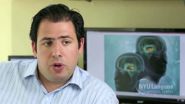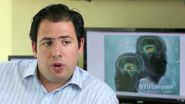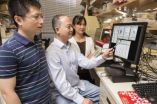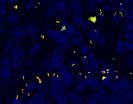(Press-News.org) VIDEO:
Michael Halassa, M.D., Ph.D. discusses his work with the thalamic reticular nucleus (TRN) and it's importance in identifying new targets for treating various psychiatric disorders like schizophrenia, autism and post-traumatic...
Click here for more information.
New York City, August 14, 2014 - Researchers at NYU Langone Medical Center and elsewhere, using a mouse model, have recorded the activity of individual nerve cells in a small part of the brain that works as a "switchboard," directing signals coming from the outside world or internal memories. Because human brain disorders such as schizophrenia, autism, and post-traumatic stress disorder typically show disturbances in that switchboard, the investigators say the work suggests new strategies in understanding and treating them.
In a study to be published in the journal Cell online Aug. 14, a team led by Michael Halassa, MD, PhD, assistant professor of psychiatry, neuroscience and physiology, and a member of the NYU Neuroscience Institute, showed how neurons in the thalamic reticular nucleus (TRN) — the so-called switchboard — direct sensory signals such as vision from the outside world, and internal information such as memories, to their appropriate destinations.
"We have never been able to observe as precisely how this structure worked before," says Dr. Halassa. "This study shows us how information can be routed in the brain, giving us tremendous insight into how it might be broken in psychiatric disorders."
For the study, researchers used a multi-electrode technique to record the activity of individual neurons in the TRN, a thin layer of nerve cells that covers the thalamus, a structure in the forebrain that relays information to the cerebral cortex, the seat of higher-level functions such as learning and language. TRN cells are known to send inhibitory signals to the thalamus, determining which information is blocked.
The activity of TRN cells, the researchers found, depended on whether the mouse was asleep or awake and alert. TRN cells that controlled sensory input were far more active during sleep, particularly during the periods of sleep when brief bursts of fast-cycling brain waves, called spindles, occur. Sleep spindles, which are associated with blocking sensory input during sleep, are known to be diminished among people with autism and schizophrenia.
Dr. Halassa says the new findings suggest that faulty TRN cells may be disrupting the appropriate filtering of information in these conditions. His group is now exploring this filtering process in animal models of schizophrenia and autism.
In experiments with alert mice, Dr. Halassa's group found that sensory TRN cells fired very little. This suggested that while these neurons block the flow of external information during sleep, they facilitate the flow of information when an animal is awake and alert.
By contrast, TRN cells that control the flow of internal signals behaved in an opposite fashion, firing very little in sleep. This lowered level of activity, Dr. Halassa suspects, may allow memories to form, which is known to occur during sleep. The thalamus has nerve connections to the hippocampus, which plays an important role in learning and memory.
In a second part of the study, Dr. Halassa's group employed a technique called optogenetics, which uses light to turn nerve cells on and off, to test whether altering TRN nerve cell firing affected attention behavior in the mice.
In one experiment, mice learned to associate a visual stimulus with food. Well-rested mice took just a second or two to find food when a stimulus was presented, while sleep-deprived mice took much longer. By turning on TRN cells that specifically controlled the visual part of the thalamus, as would happen normally in sleep, the rested mice behaved like they were sleep deprived. On the other hand, when the researchers turned off these TRN cells, sleep-deprived mice quickly found the food.
"With a flick of a light switch, we seemed able to alter the mental status of the mice, changing the speed at which information can travel in the brain," says Dr. Halassa. Mapping brain circuits and disrupting their pathways will hopefully lead to new treatment targets for a range of neuropsychiatric disorders, he adds.
INFORMATION:
This research was supported by grants from the National Institutes of Health, including NINDS (NS078115. NS077986), the NIMH (MH101209, MH103908, MH061976), NIHM (GM104948), the National Science Foundation (IIS-1307645, SBE-0354378), and the Mathematical Biosciences Institute and NARSAD Young Investigator Grant from the Brain and Behavior Research Foundation.
In addition to Halassa, other NYU Langone researchers involved in this study were Zhe Chen, PhD, and Ralf Wimmer, PhD. Additional research support was provided by Philip Brunetti and Matthew Wilson, PhD, at the Picower Institute for Learning and Memory at the Massachusetts Institute of Technology in Cambridge, Mass.; Shengli Zhao, PhD, and Fan Wang, PhD, at Duke University in Durham, NC; Basilis Zukopoulos, PhD, at Boston University; and Emery Brown, MD, PhD, at Harvard University and the Massachusetts Institute of Technology.
About NYU Langone Medical Center:
NYU Langone Medical Center, a world-class, patient-centered, integrated academic medical center, is one of the nation's premier centers for excellence in clinical care, biomedical research, and medical education. Located in the heart of Manhattan, NYU Langone is composed of four hospitals — Tisch Hospital, its flagship acute care facility; Rusk Rehabilitation; the Hospital for Joint Diseases, the Medical Center's dedicated inpatient orthopaedic hospital; and Hassenfeld Children's Hospital, a comprehensive pediatric hospital supporting a full array of children's health services across the Medical Center — plus the NYU School of Medicine, which since 1841 has trained thousands of physicians and scientists who have helped to shape the course of medical history. The Medical Center's tri-fold mission to serve, teach, and discover is achieved 365 days a year through the seamless integration of a culture devoted to excellence in patient care, education, and research. For more information, go to http://www.NYULMC.org, and interact with us on Facebook, Twitter, and YouTube.
Researchers identify a brain 'switchboard' important in attention and sleep
Study bolsters understanding of brain circuit and points to new targets for treating psychiatric disorders
2014-08-14
ELSE PRESS RELEASES FROM THIS DATE:
Genetic signal prevents immune cells from turning against the body
2014-08-14
LA JOLLA—When faced with pathogens, the immune system summons a swarm of cells made up of soldiers and peacekeepers. The peacekeeping cells tell the soldier cells to halt fighting when invaders are cleared. Without this cease-fire signal, the soldiers, known as killer T cells, continue their frenzied attack and turn on the body, causing inflammation and autoimmune disorders such as allergies, asthma, rheumatoid arthritis, multiple sclerosis and type 1 diabetes.
Now, scientists at the Salk Institute have discovered a key control mechanism on the peacekeeping cells that ...
Common mutation successfully targeted in Lou Gehrig's disease and frontotemporal dementia
2014-08-14
JUPITER, FL, August 14, 2014 – An international team led by scientists from the Florida campuses of The Scripps Research Institute (TSRI) and the Mayo Clinic have for the first time successfully designed a therapeutic strategy targeting a specific genetic mutation that causes a common form of amyotrophic lateral sclerosis (ALS), better known as Lou Gehrig's disease, as well a type of frontotemporal dementia (FTD).
The scientists developed small-molecule drug candidates and showed they interfere with the synthesis of an abnormal protein that plays a key role in causing ...
Scientists use lasers to control mouse brain switchboard
2014-08-14
VIDEO:
Scientists studied how just a few nerve cell in the mouse brain may control the switch between internal thoughts and external distractions. Using optogenetics, a technique that uses light-sensitive molecules...
Click here for more information.
Ever wonder why it's hard to focus after a bad night's sleep? Using mice and flashes of light, scientists show that just a few nerve cells in the brain may control the switch between internal thoughts and external distractions. The ...
Long antibiotic treatments: Slowly growing bacteria to blame
2014-08-14
Whether pneumonia or sepsis – infectious diseases are becoming increasingly difficult to treat. One reason for this is the growing antibiotic resistance. But even non-resistant bacteria can survive antibiotics for some time, and that's why treatments need to be continued for several days or weeks. Scientists at the Biozentrum of the University of Basel showed that bacteria with vastly different antibiotic sensitivity coexist within the same tissue. In the scientific journal Cell they report that, in particular, slowly growing pathogens hamper treatment.
Many bacteria ...
Tissue development 'roadmap' created to guide stem cell medicine
2014-08-14
In a boon to stem cell research and regenerative medicine, scientists at Boston Children's Hospital, the Wyss Institute for Biologically Inspired Engineering at Harvard University and Boston University have created a computer algorithm called CellNet as a "roadmap" for cell and tissue engineering, to ensure that cells engineered in the lab have the same favorable properties as cells in our own bodies. CellNet and its application to stem cell engineering are described in two back-to-back papers in the August 14 issue of the journal Cell.
Scientists around the world are ...
Antibodies, together with viral 'inducers,' found to control HIV in mice
2014-08-14
Although HIV can now be effectively suppressed using anti-retroviral drugs, it still comes surging back the moment the flow of drugs is stopped. Latent reservoirs of HIV-infected cells, invisible to the body's immune system and unreachable by pharmaceuticals, ensure that the infection will rebound after therapy is terminated.
But a new strategy devised by researchers at Rockefeller University harnesses the power of broadly neutralizing antibodies against HIV, along with a combination of compounds that induce viral transcription, in order to attack these latent reservoirs ...
Researchers identify a mechanism that stops progression of abnormal cells into cancer
2014-08-14
(Boston)-- Researchers from Boston University School of Medicine (BUSM) report that a tumor suppressor pathway, called the Hippo pathway, is responsible for sensing abnormal chromosome numbers in cells and triggering cell cycle arrest, thus preventing progression into cancer.
Although the link between abnormal cells and tumor suppressor pathways—like that mediated by the well known p53 gene—has been firmly established, the critical steps in between are not well understood. According to the authors, whose work appears in Cell, this work completes at least one of the ...
Researchers develop strategy to combat genetic ALS, FTD
2014-08-14
JACKSONVILLE, Fla. — A team of researchers at Mayo Clinic and The Scripps Research Institute in Florida have developed a new therapeutic strategy to combat the most common genetic risk factor for the neurodegenerative disorders amyotrophic lateral sclerosis (ALS or Lou Gehrig's disease) and frontotemporal dementia (FTD). In the Aug. 14 issue of Neuron, they also report discovery of a potential biomarker to track disease progression and the efficacy of therapies.
The scientists developed a small-molecule drug compound to prevent abnormal cellular processes caused by a ...
Inside the cell, an ocean of buffeting waves
2014-08-14
Cambridge, Mass. – August 14, 2014 – Conventional wisdom holds that the cytoplasm of mammalian cells is a viscous fluid, with organelles and proteins suspended within it, jiggling against one another and drifting at random. However, a new biophysical study led by researchers at Harvard University challenges this model and reveals that those drifting objects are subject to a very different type of environment.
The cytoplasm is actually an elastic gel, it turns out, so it puts up some resistance to simple diffusion. But energetic processes elsewhere in the cell—in the cytoskeleton, ...
Forcing chromosomes into loops may switch off sickle cell disease
2014-08-14
Scientists have altered key biological events in red blood cells, causing the cells to produce a form of hemoglobin normally absent after the newborn period. Because this hemoglobin is not affected by the inherited gene mutation that causes sickle cell disease, the cell culture findings may give rise to a new therapy for the debilitating blood disorder.
The novel approach uses protein-engineering techniques to force chromatin fiber, the substance of chromosomes, into looped structures that contact DNA at specific sites to preferentially activate genes that regulate hemoglobin. ...
LAST 30 PRESS RELEASES:
Tracing the quick synthesis of an industrially important catalyst
New software sheds light on cancer’s hidden genetic networks
UT Health San Antonio awarded $3 million in CPRIT grants to bolster cancer research and prevention efforts in South Texas
Third symposium spotlights global challenge of new contaminants in China’s fight against pollution
From straw to soil harmony: International team reveals how biochar supercharges carbon-smart farming
Myeloma: How AI is redrawing the map of cancer care
Manhattan E. Charurat, Ph.D., MHS invested as the Homer and Martha Gudelsky Distinguished Professor in Medicine at the University of Maryland School of Medicine
Insilico Medicine’s Pharma.AI Q4 Winter Launch Recap: Revolutionizing drug discovery with cutting-edge AI innovations, accelerating the path to pharmaceutical superintelligence
Nanoplastics have diet-dependent impacts on digestive system health
Brain neuron death occurs throughout life and increases with age, a natural human protein drug may halt neuron death in Alzheimer’s disease
SPIE and CLP announce the recipients of the 2025 Advanced Photonics Young Innovator Award
Lessons from the Caldor Fire’s Christmas Valley ‘Miracle’
Ant societies rose by trading individual protection for collective power
Research reveals how ancient viral DNA shapes early embryonic development
A molecular gatekeeper that controls protein synthesis
New ‘cloaking device’ concept to shield sensitive tech from magnetic fields
Researchers show impact of mountain building and climate change on alpine biodiversity
Study models the transition from Neanderthals to modern humans in Europe
University of Phoenix College of Doctoral Studies releases white paper on AI-driven skilling to reduce burnout and restore worker autonomy
AIs fail at the game of visual “telephone”
The levers for a sustainable food system
Potential changes in US homelessness by ending federal support for housing first programs
Vulnerability of large language models to prompt injection when providing medical advice
Researchers develop new system for high-energy-density, long-life, multi-electron transfer bromine-based flow batteries
Ending federal support for housing first programs could increase U.S. homelessness by 5% in one year, new JAMA study finds
New research uncovers molecular ‘safety switch’ shielding cancers from immune attack
Bacteria resisting viral infection can still sink carbon to ocean floor
Younger biological age may increase depression risk in older women during COVID-19
Bharat Innovates 2026 National Basecamp Showcases India’s Most Promising Deep-Tech Ventures
Here’s what determines whether your income level rises or falls
[Press-News.org] Researchers identify a brain 'switchboard' important in attention and sleepStudy bolsters understanding of brain circuit and points to new targets for treating psychiatric disorders







